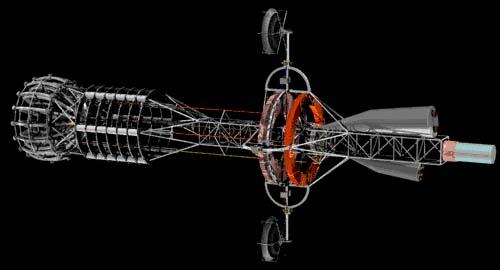In Part 8 of this blog on space in the 21st century we reviewed current and potential technologies to go beyond the limits imposed by chemical rockets in our quest to reach neighbouring destinations in space. Now we will look at technologies that may seem improbable at present, some described in science fiction and some that may become science fact if not in the 21st century, then further in our future.
Antimatter Engines
What is antimatter? The term comes up in so many episodes of Star Trek and other science fiction TV dramas that you may think it is fantasy rather than fact. But antimatter does exist in the form of subatomic particles with properties opposite to those particles that form matter. For example a positron is the antimatter equivalent to an electron. When the two meet they annihilate each other and release energy.
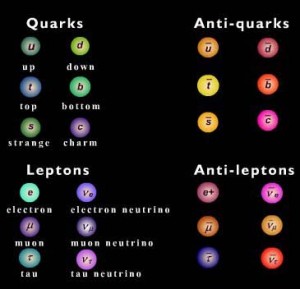
Where can you find antimatter on Earth?– in terrestrial gamma-ray flashes (TGF) associated with lightning strikes during thunderstorms. In fact, about 10% of particles erupting from lightning are positrons. NASA’s orbiting Fermi Gamma-Ray Space Telescope has detected in lightning antimatter that subsequently beamed into space using Earth’s magnetic field as a conduit.
How long does antimatter hang around? Not very. The Fermi telescope has recorded free positrons in the form of gamma ray bursts that survived 23 milliseconds before encountering electrons and their destruction. Most recently scientists at CERN in Switzerland set a new world record by capturing anti-hydrogen atoms and containing them for 16 minutes.
When a gram of antimatter encounters a gram of normal matter they experience mutual destruction and in the process generate as much energy as all of the energy stored in the liquid hydrogen fuel of 23 Space Shuttle external fuel tanks. A kilogram of the stuff would create energy equal to two billion kilograms of hydrocarbon, or more than one thousand times the energy from a kilogram of plutonium or uranium in a nuclear reactor.
CERN has demonstrated that antimatter can be contained using magnetic and electrical fields in a similar manner to the plasma technology containment used by the VASIMIR rocket engine. The big problem with antimatter, however, is how to make it in quantities sufficient to fuel a rocket. Today when we produce antimatter it is in minute amounts, a few nanograms. And those few nanograms cost a fortune.
Fortunately we don’t need a lot of antimatter to power a rocket to take us to the far reaches of the Solar System and beyond. As little as the equivalent of a grain of rice would be enough to fuel a rocket to Mars and back. With 17 grams of the stuff we could send a robotic spacecraft to our nearest neighbouring star, Alpha Centauri. The voyage would take 40 years travelling at 10% of the speed of light. To shorten the trip we would need 70 grams of the stuff.
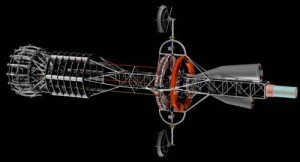
So how do we harvest antimatter, the proverbial lightning in a bottle? Well short of milking lightning bolts for the antimatter they create, a somewhat difficult endeavour, we need to look elsewhere to where antimatter freely exists. And it appears to exist in orbit around the Earth. Recently discovered by PAMELA (Payload for Antimatter Matter Exploration and Light-Nuclei Astrophysics), a satellite launched in 2006, it seems our Earth is surrounded by a ring of antimatter particles contained by our magnetic field. And other planets that produce lightning storms and have magnetic fields are probably similarly surrounded by rings of antimatter. To harvest this antimatter resource researchers have proposed a magnetic trap that would orbit a planet to harvest and contain antiparticles (see image below).
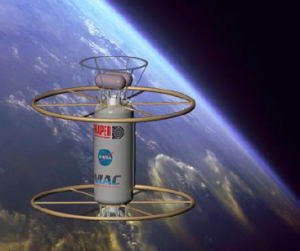
Fusion Engines
We have yet to develop a nuclear fusion reactor but that hasn’t stopped scientists and engineers from looking at fusion as an energy source for interplanetary and interstellar travel. Fusion-powered rockets would use hydrogen as propellant and would harvest hydrogen while travelling through space using a large trap like scoop.
Fusion rocket engines would use magnetic field containment similar to VASIMIR but the reaction chamber in which the plasma is contained would be replaced by a Gas Dynamic Mirror (GDM). The GDM engine instead would be a long and thin magnetic bottle with mirror magnets at both ends to contain the fusion reaction and prevent the plasma from leaking in many directions rather than the intended one to generate thrust.
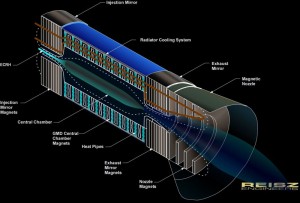
The proposed fuel for fusion rockets would be a combination of deuterium and Helium-3. While the latter is rare on Earth it is widely present in lunar surface soils and is one justification for humans returning to the Moon. Mining the Moon for Helium-3 and rare earths would provide the materials and fuel for fusion engines.
Warp Engines
Are warp engines for real? We have grown up with warp speed ever since Star Trek first aired on television in the 1960s. Warp 1 is the speed of light. Warp 2 is 10 times the speed of light. Is it even possible to travel at light speed or beyond it?
Warp technology defies the physical limit that nothing can travel faster than the speed of light. Yet didn’t we hear in February 2012 that CERN scientists had recorded neutrinos travelling faster than light speed, 299,792 kilometers (186, 282 miles) per second? Widely reported the CERN team performed the experiment twice getting similar results. Did this mean we could develop a technology like warp engines.
Unfortunately the scientists went over their data carefully and discovered the 60 nanosecond discrepancy recorded by the neutrinos early arrival at faster than light speed was really a faulty sensor reading and not the speed of the neutrinos themselves.
Light is truly a barrier because matter is made from the same stuff as light itself. But in Star Trek space ships achieve speeds hundreds of times light speed. They do this theoretically because a warp engine generates a bubble around it compressing the space time in front and expanding the space time behind. Inside the bubble the spaceship experiences stationary space time allowing it to go anywhere in the galaxy at faster than light speed.
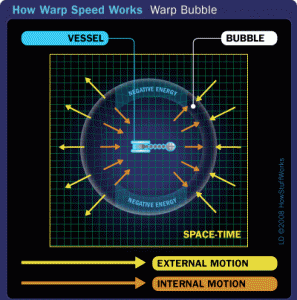
The fuel of the warp drive is antimatter. But no antimatter-matter annihilation force can create a warp field. So for all intents and purposes warp engines remain purely theoretical until we can discover a new physics that unseats Einstein’s Theory of Relativity.
In our next blog on outer space we will look at the implications of the commercialization of space in the 21st century and how that change to profit-driven space enterprise will accelerate our outward urge.

